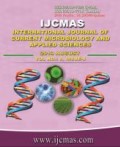


 National Academy of Agricultural Sciences (NAAS)
National Academy of Agricultural Sciences (NAAS)

|
PRINT ISSN : 2319-7692
Online ISSN : 2319-7706 Issues : 12 per year Publisher : Excellent Publishers Email : editorijcmas@gmail.com / submit@ijcmas.com Editor-in-chief: Dr.M.Prakash Index Copernicus ICV 2018: 95.39 NAAS RATING 2020: 5.38 |
Antibiotic resistance has risen perilously in all parts of the world. The lack of appropriate therapeutics to encounter resistant pathogens has enhanced the urge for the development of either new antibiotics or different therapeutic combinations. Hence, this study was aimed to evaluate the antimicrobial efficacy of cefepime plus sulbactam in comparison with cefepime alone and other therapeutics such as third generation cephalosporin (ceftazidime), β-lactam and β-lactamase inhibitor combinations (pipercaillin + tazobactam and cefoperazone + sulbactam) and carbapenem drugs (imepenem and meropenem. The present study was a prospective study conducted over a period of five months (January 2019 – May 2019) in the Department of Microbiology, Grecian Super Speciality Hospital, Mohali (Punjab, India). This study included clinical isolates obtained from clinical specimens collected from outdoor and indoor patients. Antibiotic susceptibility testing was executed in accordance with the recommendations of Clinical Laboratory Standards Institute (CLSI) guidelines. Out of 751 collected specimens, urine specimens contributed 49.67% followed by blood (17.98%), endotracheal secretions (15.98%), sputum (7.06%), pus (4.93%), bronchoalveolar lavage (BAL) (1.73%), wound swab (1.59%), body fluids (0.79%) and CSF (0.27%). Escherichia coli were found most prevalent (55.66%) pathogen along with 16.91, 13.72 and 11.32% prevalence of Pseudomonas aeruginosa, Klebsiella penumoniae and Acinetobacter baumannii respectively whereas rest 2.39% presence of other pathogens (Providencia spp., Proteus spp., Morganella morganii and Citrobacter spp.) was also observed. The in-vitro antibacterial activity revealed that cefepime + sulbactam (82.29%) was 41.81% more active than cefepime alone. Data also depicted 25.17 to 58.06% superiority of cefepime + sulbactam over third generation cephalosporin (ceftazidime) and other BL-BLI combinations (piperacillin + tazobactam and cefoperazone + sulbactam) and also exhibited 2.4% and 17.58% more sensitivity than meropenem and imipenem respectively, hence, found comparable to carbapenem drugs. Susceptibility profile data revealed the equivalence of cefepime + sulbactam with carbapenem drugs and strong superiority over third generation cephalosporin and other BL + BLI combinations against resistant gram negative pathogens. Therefore, the antibiotic resistance breaking efficacy of cefepime plus sulbactam confirms this combination as a carbapenem sparing agent and also as a better choice over other BL-BLI combinations to treat infectious pathogens.
 |
 |
 |
 |
 |